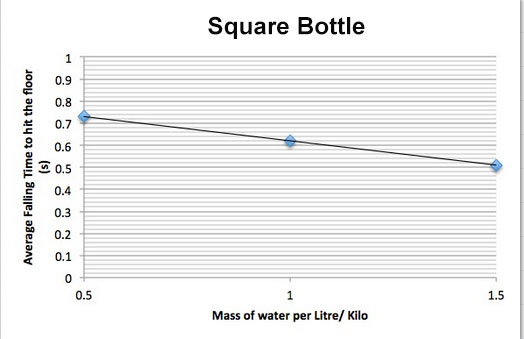1) Hi Nada, can you tell us what you've been up to since graduating from THINK Global School in 2022? Since graduating in 2022, I've been pursuing a passion I found while at TGS, sustainability, and I am currently majoring in engineering in renewable energy systems at Al Akhawayn University, in Ifrane, Morocco. But there is way more than that! I've had a chance also to explore the world of...
Read More

While enrolled at THINK Global School, students are encouraged to be creative during the course of their studies and travels. When the students document these thoughts, we are often delighted with the results. In “Falling Objects,” ninth graders Kiana F. and Glai T. share the results of their experiments with velocity. The research was originally conducted as an exercise for Guillermo Machado’s mathematics class.
Falling Down, Down, Down
There are events where perfection and precision are everything: activities like skydiving, bungee jumping and the dropping of bombs all depend on how mass affects the speed at which an item falls. In terms of going skydiving, safety is paramount. It would be extremely unsafe to let a 300 pound person and a 150 pound person fall with the same size of parachute. The reason being the rate of speed at which the person falls is going to be affected by their mass, so everything has to be altered accordingly. In the time that an object falls, it also slowly accelerates. So you have to find a different answer if you want to know the average speed or how much it accelerated. The overall width of the person is going to be different if one person weighs 300 pounds and the other weighs 150 pounds. The more width you have when falling will create drag and slow down the speed as well. Glai and I researched this topic because we had a shared interest in finding the reason behind differing speeds of falling objects. We both want to go sky diving at some point in our lives, so we wanted to know what is going to change the speed of us falling, and how the mass and shape affected the time it takes for the object to fall. So the question is, how does the mass and shape of an object alter the time it takes to hit the ground?
Pre-Reflection
Our first thoughts and hypothesis was if the mass of the object is greater, then the time at which the object falls is smaller. We then took into account that the different shapes of the bottle could affect the time at which the object fell. With the shape of the bottle in mind, we concluded that the rocket-shaped bottle will have the fastest time because it is the most aerodynamic bottle and will create less drag. The sphere-shaped bottle will be the second fastest. The square shaped bottle will have the longest time because it has a larger surface area, therefore creating a bigger drag.
What We Actually Did
First, we got three different types of bottles (circular, square and rocket). After we had the three types of bottles, we took the measurements of the height we were going to drop the bottles from. Glai stood on top of the counter, and we used the measuring tape to measure the cupboard. Next, we added Glai’s height to it, and then we started the experiment. We first filled the circular shape with two liters of water and dropped the bottle facing upwards three times. Every time Glai dropped the bottle, Kiana would use the timer to measure the time it took for the bottle to drop to the ground. We repeated the steps for the different types of bottles (sphere, square, rocket) and mass ( 2 Liter, 1 Liter and ½ Liter.) After collecting all the data, we used the calculator to find the average of each bottle. With the data we had, we then created a graph to represent the conclusions we made during and after our project.

As you can see, all of the results from the experiments we conducted ended in the same results. The slightly different results all had a longer time at 0.5 liters of water and a shorter time at 1.5 liters of water. The shape of the bottle did not seem to make a difference. I think that if the shapes were drastically different there would have been a consecutive pattern with the shapes of bottles.
Original Plans
We were originally going to drop water bottles off the top of a twelve story building, but we did not understand what that would entail. We planned on using a string to measure the distance from the roof to the ground, recording the data and placing it in a chart. Based off of this, we would find the average between each set of three bottles by comparing how the shape affected the time it took for each to fall. Next we would compare how the different amounts of water in the bottles would affect time by using the string to measure the height of the building, and then dropping the three bottles off of it with different amounts of water in them; we would do this one time each for every mass level (.5/1.5/2).
We thought about the effects that dropping a bottle off the roof would cause and decided to drop water bottles off of a kitchen counter instead. We did not drop it off of the roof because the bottle would probably have exploded, wasting money and water. Also, if it had hit someone, they could have died from the impact. Dropping a bottle off of the roof also would have been harder to measure than a smaller space and most likely inaccurate and risky, so we determined the best thing to do was to drop the water bottles in a smaller, more controlled environment.
Post-Reflection
We took the measurements using three different types of 1.5 liters bottles. We made some changes from our plan to create more accurate results. First, we decided to get three different shapes of bottles instead of using the same shape. We did this because the time is affected by how aerodynamic the object you are using is. Doing this gave us the chance to compare how mass affects the time and how shape affects time. We noticed that if the mass of the object is greater, then the time at which the object falls is smaller. Our hypothesis was correct as the more mass the object has, the more it is allowed to accelerate as it is falling. It accelerates because as mass increases you have a greater ability to defy gravity. If the shape of the object has a larger area, then the time at which the object falls will be greater. We assumed this because the bottle with a greater area creates more drag, rendering the bottle less aerodynamic. It was incorrect, but I think if the difference between shapes of bottles was really noticeable it would have affected the time it took for the bottles to fall. It would have been a better experiment if we had used a more precise and exact location to drop the water, as we would have used more drastically different shapes of bottles and had more trials to increase the accuracy. Overall we think the project was an enjoyable, learning experience.